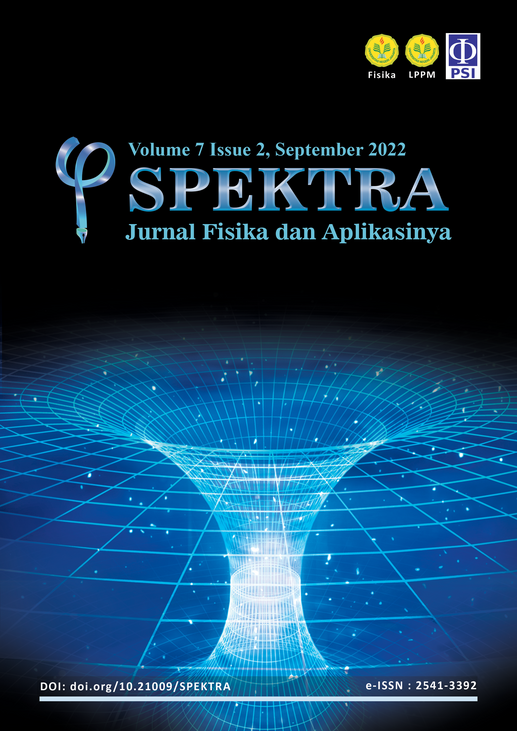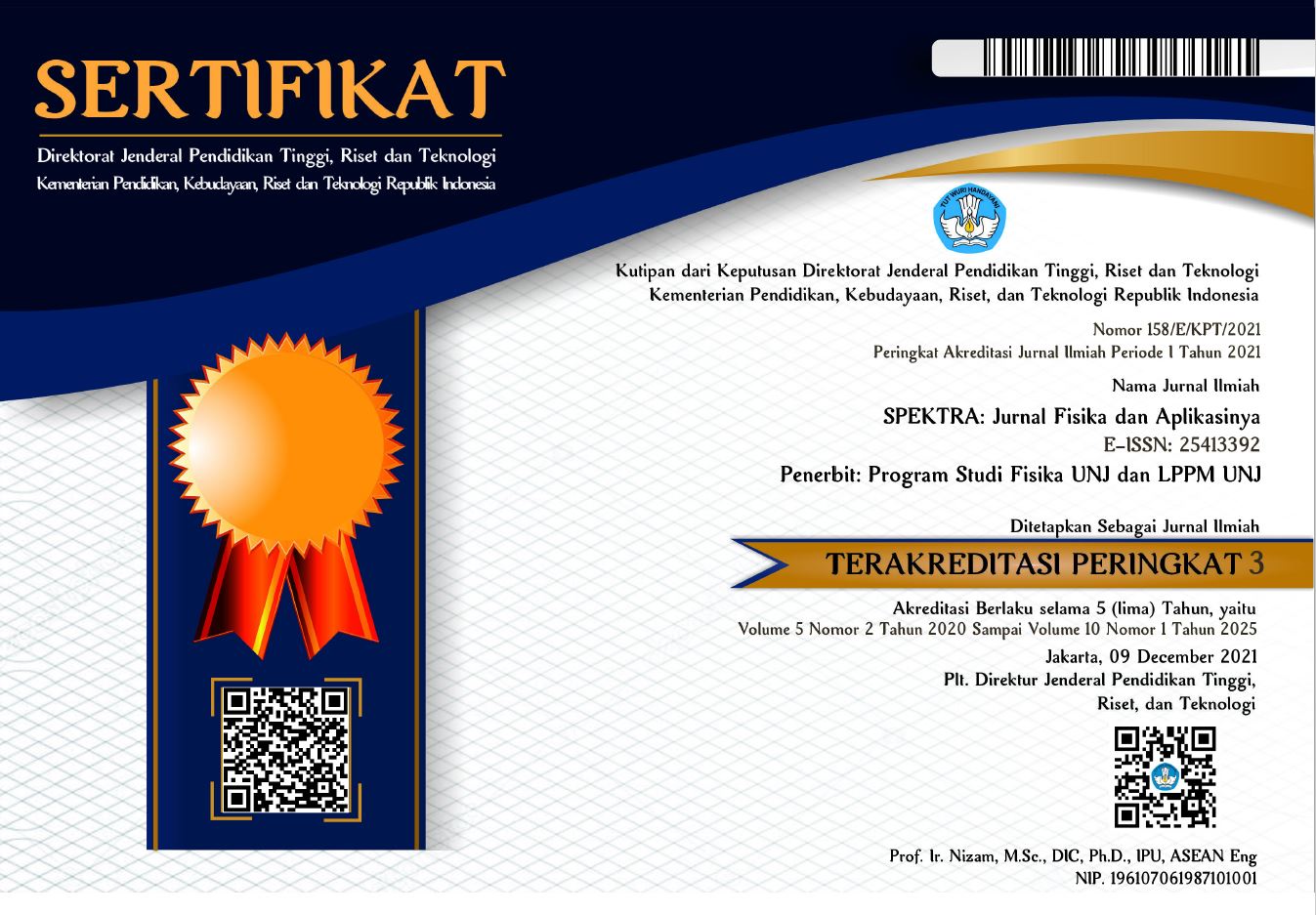ROLE OF ISOVECTOR-ISOSCALAR COUPLING ON CHARGE RADIUS OF HEAVY AND SUPERHEAVY NUCLEI
Abstract
We have investigated the effect of the isovector-isoscalar coupling on the finite nuclei and nuclear matter properties, the neutron skin thickness of 208Pb, and the charge radius on heavy and superheavy nuclei calculated by the relativistic mean-field (RMF) model. In this work, we generates two parameter sets, i.e., PTE16 and PTE31. The numbers 16 and 31 denote the isovector-isoscalar coupling terms, while T and E denote the tensor coupling and electromagnetic exchange terms, respectively. We found that PTE16 and PTE31 are compatible with the constraints obtained by R. Essick, et al., arXiv: 2102.10074v1 [nucl-th] (2021). We also found that the increase of the isovector-isoscalar coupling terms gives a significant effect on the binding energy and the charge radius on heavy nuclei except for the charge radius of 208Pb. Increased of the isovector-isoscalar coupling terms make the values of charge radius prediction increase too, but vice versa for the neutron skin thickness and nuclear matter prediction. PTE31 yields symmetry energy J = 31.521 MeV, slope L = 57.643 MeV, and neutron skin thickness = 0.21419 fm. While the β2 correction (for deform nuclei) does not always give a significant effect on the charge radius.
References
X. X. Dong et al., “Novel Bayesian neural network based approach for nuclear charge radii,” Physical Review C, vol. 105, p. 014308, 2022.
R. An et al., “Systematic study of nuclear charge radii along Z = 98-120 isotopic chains,” arXiv preprint, vol. 2112, p. 03829, 2021.
T. Li et.al., “Compilation of recent Nuclear Ground State Charge Radius Measurements and Test for Models,” Atomic Data and Nuclear Data Tables, vol. 140, p. 101440, 2021.
J. Meng, P. Ring and P. W. Zou, “in Relativistic Density Functional for Nuclear Structure (International Review of Nuclear Physics-Vol 10),” edited by J. Meng (World Scientific, Singapore, 2016.
N. Liliani et al., “Tensors and Coulomb Exchange Terms in the RelativisticMean-Field Model with the Delta Meson and Isoscalar-Isovector Coupling,” Physical Review C, vol. 104, p. 015804, 2021.
J. Zenihiro et al., “Neutron density distributions of 204,206,208Pb deduced via proton elastic scattering at Ep=295 MeV,” Physical Review C, vol. 82, p. 044611, 2010.
S. Abrahamyan et al., “Measurement of the Neutron Radius of 208Pb through Parity Violation in Electron Scattering,” Physical Review Letter, vol. 108, no. 11, p. 112502, 2012.
C. J. Horowitz et al., “Weak charge form factor and radius of 208Pb through parity violation in electron scattering,” Physical Review C, vol. 85, p. 032501, 2012.
C. H. Hyun, “Neutron skin Thickness of 48Ca, 132Sn and 208Pb with KIDS density functional,” arXiv: 2112, p. 00996, 2021.
R. Essick et al., “Astrophysical Constraint on the Symmetry Energy and the Neutron Skin of 208Pb with Minimal Modeling Assumptions,” Physical Review Letters, vol. 127, no. 19, p. 192701, 2021.
N. Liliani et al., “Impacts of the tensor couplings of ω and ρ mesons and Coulomb-exchange terms on superheavy nuclei and their relation to the symmetry energy,” Physical Review C, vol. 93, no. 5, p. 054322, 2016.
F. J. Fattoyev et al., “Neutron Skins and Neutron Stars in the Multimessenger Era,” Physical Review Letter, vol. 120, p. 172702, 2018.
N. Liliani et al., “Pengaruh Kopling Tensor, Isovektor-Isoskalar Dan Pertukaran Elektromagnetik Terhadap Prediksi Double Magic Nuclei 292120,” Spektra: Jurnal Fisika dan Aplikasinya, vol. 16, no. 1, pp. 28-33, 2015.
K. Zhang et al., “Nuclear Mass Table in Deformed Relativistic Hartree-Bogoliubov Theory in Continuum,” Atomic Data and Nuclear Data Tables, vol. 144, p. 101488, 2022.
S. V. Pineda et al., “Charge Radius of Neutron-Deficient 54Ni and Symmetry Energy Constraints Using the Difference in Mirror Pair Charge Radii,” Physical Review Letter, vol. 127, p. 182503, 2021.
T. G. Yue et al., “Constraints on the Symmetry Energy from PREX-II in the Multimessenger Era,” Physical Review Research, vol. 4, no. 2, p. L022054, 2022.
B. T. Reed et al., “Implications of PREX-II on the equation of state of neutron-rich matter,” Physical Review Letter, vol. 126, no. 17, p. 172503, 2021.
Copyright (c) 2022 Netta Liliani

This work is licensed under a Creative Commons Attribution 4.0 International License.
SPEKTRA: Jurnal Fisika dan Aplikasinya allow the author(s) to hold the copyright without restrictions and allow the author(s) to retain publishing rights without restrictions. SPEKTRA: Jurnal Fisika dan Aplikasinya CC-BY or an equivalent license as the optimal license for the publication, distribution, use, and reuse of scholarly work. In developing strategy and setting priorities, SPEKTRA: Jurnal Fisika dan Aplikasinya recognize that free access is better than priced access, libre access is better than free access, and libre under CC-BY or the equivalent is better than libre under more restrictive open licenses. We should achieve what we can when we can. We should not delay achieving free in order to achieve libre, and we should not stop with free when we can achieve libre.
 SPEKTRA: Jurnal Fisika dan Aplikasinya is licensed under a Creative Commons Attribution 4.0 International License.
SPEKTRA: Jurnal Fisika dan Aplikasinya is licensed under a Creative Commons Attribution 4.0 International License.
You are free to:
Share - copy and redistribute the material in any medium or format
Adapt - remix, transform, and build upon the material for any purpose, even commercially.
The licensor cannot revoke these freedoms as long as you follow the license terms.










